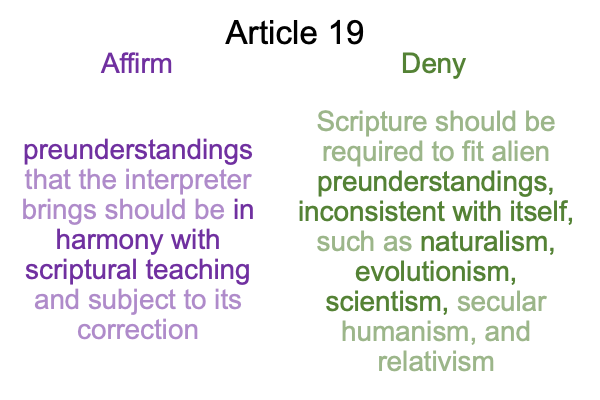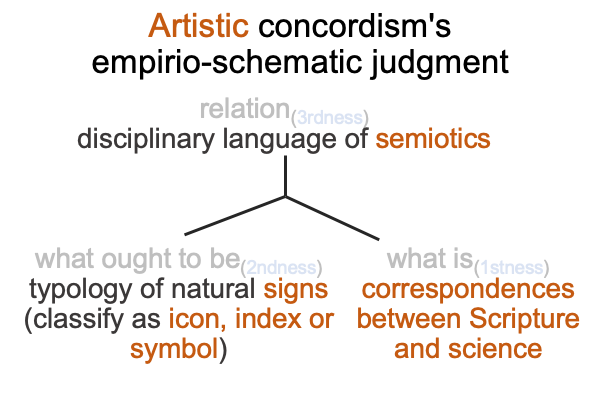Looking at Hugh Ross’s Book (2023) “Rescuing Inerrancy” (Part 8 of 25)
0060 Let me start with nature as thirdness and grace as firstness.

0061 Yes, this judgment is actionable.
Nature as what is will become the normal context3 of an actionable judgment.
Grace as what ought to be will enter the realm of possibility1.
Here is a picture of the resulting nested form.

“Grace” and “nature” have separate referents. These referents now occupy different positions in a category-based nested form.
0062 To start, the actuality2 looks awkward. The normal context of nature3 is separate from and distinct from the potential of grace1. Is that enough? I don’t think so. When the normal context is nature3, the possibility of grace1should be close to zero.
Why would this be so?
The logics of thirdness are exclusion, complement and alignment. Grace does not complement or align with nature because it is distinct and separate. So nature3 as a normal context will strive to exclude grace1 as a possibility.
I ask, “Is there a thing2 that represents the dyadic actuality portrayed above, in a convincing manner?”
The first item that comes to my mind are organizational protocols2. Organizational protocols2 systematically exclude chance events, which would include moments of grace1, in the normal context of nature3.
0063 If that is so, then organizational protocols2 actualize the exclusion of the potential of grace1. After all, exclusion is one of the logics of thirdness. So, I wonder, “What would go into the slot for possibility, that further indicates that grace1 is excluded?”
Well, what about science, especially the philosophy of the mechanical philosophers?
Unfortunately, the empirio-schematic judgment, when unfolded into a content-level category-based nested form, looks like it would go into the slot for protocols2b.

0064 So, what if I elevate nature3 to the perspectivec level and put scientific inquiry2 into the contenta level? Then, scientific inquiry2a provides models1c that contribute to protocols2c and exclude grace as a perspectivec-level potential1c.

The nice feature of the content-level is that it fulfills the scientist’s self-impression that his work entails a search for truth. The logos3a (the word that is eventually codified in specialized disciplinary languages) brings the actuality of scientific inquiry2a (manifesting the protocols2c of the empirio-schematic judgment2c) into relation with the potential for ‘truth’1a. Truth is not the same as grace. Truth1a is… well… what science reveals1a.
0065 I am only missing the situation level, which must belong to the scientist.

The interscope is a category-based nested form composed of category-based nested forms. See A Primer on the Category-Based Nested Form and A Primer on Sensible and Social Construction, by Razie Mah, available at smashwords and other e-book venues.
Here is how to state the above figure.
On the perspective level, the normal context of nature3c brings the actuality of protocols2c into relation with the possibility of ‘models’1c. The models1c contextualize both scientific specializations2b and scientific inquiry2a.
On the situation level, the normal context of expertise3b brings the actuality of specialized jobs and research positions2binto relation with the potential of ‘institutionalizing scientific inquiry’1b. Scientific work becomes more and more professional during the nineteenth and twentieth centuries. Today, academic certification “guarantees” expertise3b.
On the content level, the normal context of logos3a (or the “words” of a disciplinary language) brings the actuality of scientific inquiry2a (the empirio-schematic judgment) into relation with the potential of ‘truth’1a (the validity of models accounting for observations and measurements of phenomena). Of course, the terms, “logos” and “truth” also have more expansive connotations.
0066 In sum, I have learned that the widespread acceptance of the distinction and the separation of grace and nature since the recovery of Aristotle by Saint Thomas Aquinas has significant consequences. The distinction and separationare regarded as real as the distinction and separation of two referents or “things”. These two “things” are products of explicit abstraction.
Explicit abstraction is potentiated when humans adopt speech-alone talk during the first singularity, starting around 7825 years ago. No precise date has been set. Before that transition, all human cultures practice hand-speech talk, which combines the iconicity and indexality of hand-talk with the symbol-generating qualities of speech. Unlike hand talk, speech cannot picture or point to anything. So, speech serves as an adornment to hand talk, even as it takes on a life of its own during the Upper Paleolithic.
0067 Hand-talk and hand-speech talk facilitate implicit abstraction in the Lebenswelt that we evolved in.
Speech-alone talk facilitates explicit abstraction in our current Lebenswelt.
0068 The three-level interscope pictured above allows the inquirer to conduct implicit abstraction based on explicit terms occupying locations in a purely relational structure called “an interscope”. In the interscope, perspectivec brings situationb into relation with the potential of contenta. This interscope derives from imbuing nature (what is) with thirdness.






















